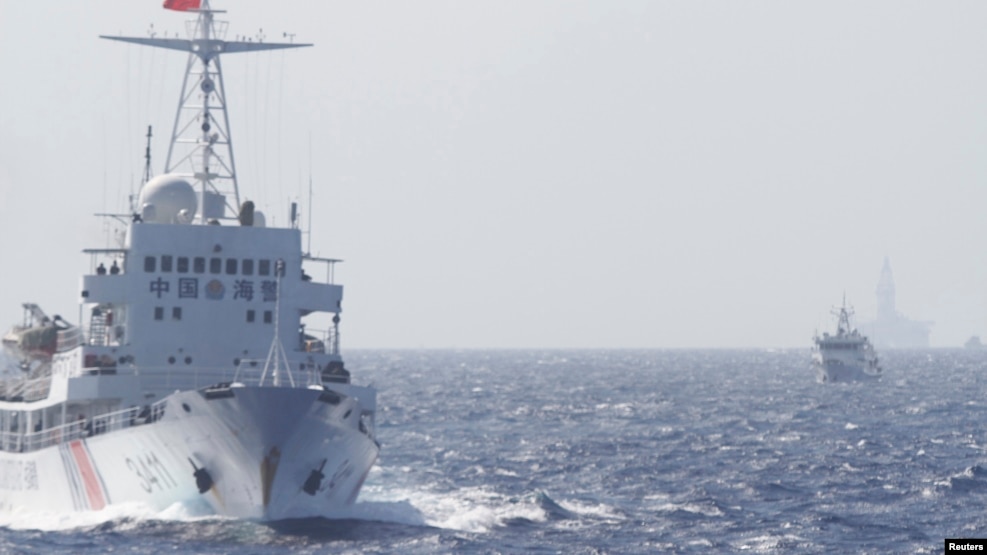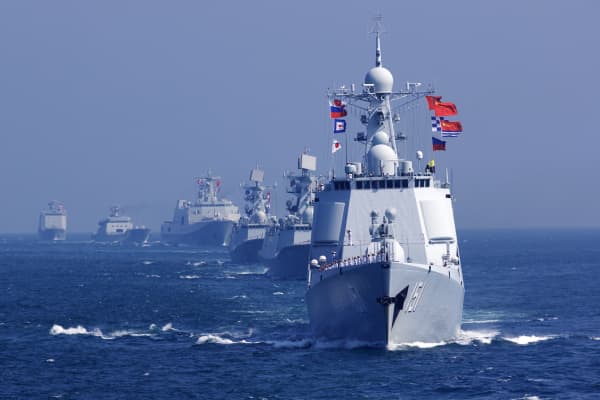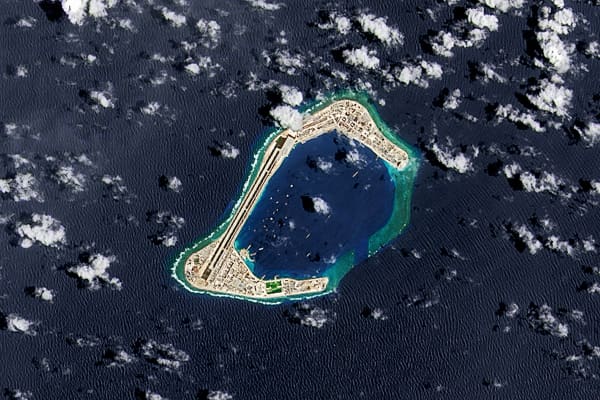By HELEN CLARK

Former ExxonMobil executive Rex Tillerson testifies during his confirmation hearing for Secretary of State before the Senate Foreign Relations Committee in Washington, DC, January 11, 2017.
US energy giant Exxon Mobil and state-owned PetroVietnam agreed this month to develop Vietnam’s largest natural gas-fired power generation project, a US$10 billion joint venture known as ‘Blue Whale’ (Ca Voi Xanh).
The deal, signed while outgoing US Secretary of State John Kerry was on his last official visit to Vietnam, threatens to create new ripples in the contested South China Sea under the new Donald Trump administration.
The project is scheduled to come online in 2023 and will draw on a natural gas field situated 88 kilometers from Vietnam’s central Quang Nam province in the South China Sea.
The project is scheduled to come online in 2023 and will draw on a natural gas field situated 88 kilometers from Vietnam’s central Quang Nam province in the South China Sea.
The field is estimated to hold some 150 billion cubic meters of natural gas, three times the amount of Vietnam’s current largest gas project, a joint venture with Russia’s Gazprom in the southern Con Son Basin.
Exxon Mobil will construct an 88-kilometer sea-to-shore pipeline, while PetroVietnam’s Exploration Production Corporation (PVEC) subsidiary will build gas treatment and four power plants with a total capacity of 3 gigawatts, according to reports.
Exxon Mobil will construct an 88-kilometer sea-to-shore pipeline, while PetroVietnam’s Exploration Production Corporation (PVEC) subsidiary will build gas treatment and four power plants with a total capacity of 3 gigawatts, according to reports.
A planned expansion phase will generate enough gas for another 5,750 megawatts of power and petrochemical production, the reports said.
PetroVietnam estimates the project will produce US$20 billion for state coffers over an undefined timeline.
The deal comes against the backdrop of Trump’s decision to scrap the Trans-Pacific Partnership agreement, a US-initiated trade pact of 12 Pacific Rim countries of which Vietnam stood the most to gain.
The deal comes against the backdrop of Trump’s decision to scrap the Trans-Pacific Partnership agreement, a US-initiated trade pact of 12 Pacific Rim countries of which Vietnam stood the most to gain.
The tariff-slashing deal, if it had been implemented, projected to boost Vietnam’s gross domestic product (GDP) by 11%, or US$36 billion, and exports by 28% over the decade spanning 2015-2025. Vietnam is a signatory to the China-led Regional Cooperative Economic Partnership, which does not require the same type of economic reforms that TPP would have required.
The ExxonMobil project will have a strong diplomatic defender in US Secretary of State designate Rex Tillerson, Exxon Mobil’s former chairman and chief executive officer.
The ExxonMobil project will have a strong diplomatic defender in US Secretary of State designate Rex Tillerson, Exxon Mobil’s former chairman and chief executive officer.
Two days before Kerry met with Vietnamese leaders, Tillerson threatened China over the South China Sea, saying in a Senate confirmation hearing that the Trump administration would send Beijing a “clear signal” and “block” China’s access to artificial islands it has built in international waters.
While within Vietnam’s exclusive economic zone (EEZ), the deepwater field is also in an area China claims on its nine-dash map, which lays wide-ranging claim to 90% of the entire South China Sea.
While within Vietnam’s exclusive economic zone (EEZ), the deepwater field is also in an area China claims on its nine-dash map, which lays wide-ranging claim to 90% of the entire South China Sea.
In 2011, China indirectly warned Exxon Mobil soon after the company announced a big gas find at Block 118, contained in the Blue Whale project zone, saying foreign companies should refrain from exploration in the "contested" area.
Other multinational energy companies appeared to buckle under China’s pressure by abandoning their exploration activities with Vietnam.
China has also explored in the same area and is believed to have discovered its first commercially viable store of fuel in the South China Sea.
China has also explored in the same area and is believed to have discovered its first commercially viable store of fuel in the South China Sea.
In mid-2014, state-run China National Offshore Oil Company (CNOOC) positioned a massive deepwater exploration rig in the contested area, setting off sea skirmishes and sparking anti-China riots in Vietnam that resulted in arson attacks on Chinese factories and the exodus of hundreds of fearful Chinese.

Tillerson and CNOOC chairman Wang Yilin met in Beijing on May 14, 2014, where the two executives discussed “further cooperation” between the two firms without giving specific details, according to a Reuters report.
After those closed door talks, neither side announced any production plans in the area until this month’s Exxon Mobil-PetroVietnam deal.
Exxon Mobil also has exploration rights to blocks that could be "contested" in adjoining areas.
Vietnam expert Carlyle Thayer wrote in a January 16 background briefing paper on the deal that Tillerson “would have institutional knowledge of Chinese attempts to intimidate Exxon Mobil from investing in Vietnam dating back to 2007-8” and that the businessman-cum-envoy “will not be receptive to Chinese protests at the Exxon Mobil deal with PetroVietnam.”
Vietnam expert Carlyle Thayer wrote in a January 16 background briefing paper on the deal that Tillerson “would have institutional knowledge of Chinese attempts to intimidate Exxon Mobil from investing in Vietnam dating back to 2007-8” and that the businessman-cum-envoy “will not be receptive to Chinese protests at the Exxon Mobil deal with PetroVietnam.”
Thayer wrote that Chinese officials had previously privately warned Western oil companies that their interests in China would suffer if they assisted Vietnam’s exploration ambitions.
China has not commented specifically on the multi-billion dollar Blue Whale deal, though mouthpiece media has blasted Tillerson’s Senate confirmation comments on the South China Sea. The China Daily said in a January 13 op-ed that Tillerson’s remarks were “a mish-mash of naivety, shortsightedness, worn-out prejudices and unrealistic political fantasies.”
China has not commented specifically on the multi-billion dollar Blue Whale deal, though mouthpiece media has blasted Tillerson’s Senate confirmation comments on the South China Sea. The China Daily said in a January 13 op-ed that Tillerson’s remarks were “a mish-mash of naivety, shortsightedness, worn-out prejudices and unrealistic political fantasies.”
The Exxon Mobil-PetroVietnam venture was announced while Kerry was in Hanoi and Vietnam Communist Party General Secretary Nguyen Phu Trong was in Beijing meeting with Xi Jinping, where the two signed a joint communiqué on cooperation and peace.
The pro forma agreement is not expected to resolve or even mitigate the South China Sea disputes.
Hanoi and Beijing maintain a wide network of cooperative ties and agreements despite their South China Sea disputes.
Hanoi and Beijing maintain a wide network of cooperative ties and agreements despite their South China Sea disputes.
Whether these agreements, including a joint steering committee to oversee relations, help to restrain bilateral ructions or are useless in the face of serious disputes, such as China’s 2014 incursion into Vietnam’s EEZ, is difficult to say due to the opaque nature of both nominally communist regimes.

This handout photo taken on June 23, 2014 shows a Chinese boat (L) ramming a Vietnamese vessel (R) in contested waters near China’s deep sea drilling rig in the South China Sea.
Bilateral ties cratered after the 2014 anti-Chinese riots and relations were not reset until November 2015, when Xi Jinping visited Hanoi.

This handout photo taken on June 23, 2014 shows a Chinese boat (L) ramming a Vietnamese vessel (R) in contested waters near China’s deep sea drilling rig in the South China Sea.
Bilateral ties cratered after the 2014 anti-Chinese riots and relations were not reset until November 2015, when Xi Jinping visited Hanoi.
During Xi’s visit a dozen new bilateral agreements were signed under a comprehensive strategic cooperative partnership where China promised US$157 million worth of investments for hospitals and schools and US$500 million for infrastructure.
The sea disputes have been accentuated and complicated by recent joint exploration ventures Hanoi has entered into with foreign energy concerns.
The sea disputes have been accentuated and complicated by recent joint exploration ventures Hanoi has entered into with foreign energy concerns.
The deals have also added new geostrategic dimensions to the volatile region.
For instance, India’s drive to sell Hanoi advanced missiles and other power-projecting weaponry is believed to be motivated in part to protect its ONGC Videsh Ltd energy company’s joint exploration ventures with Vietnam in the South China Sea.
China’s threat to Vietnam’s exploration activities in the area, however, is as much about political power as natural resources.
China’s threat to Vietnam’s exploration activities in the area, however, is as much about political power as natural resources.
U.S. Energy Information Agency (EIA) estimated in 2013 that the South China Sea holds 11 billion barrels of oil and 190 trillion cubic feet of natural gas, including both proven and possible reserves. China’s estimates for the sea are higher, with the state-run China National Offshore Oil Corporation (CNOOC) projecting 125 billion barrels of oil and 500 trillion cubic feet of gas.
China consumed around 1.7 billion barrels of oil in 2015, according to industry estimates.
Like China, Vietnam sorely needs the energy to fuel its fast expanding industrializing economy.
Like China, Vietnam sorely needs the energy to fuel its fast expanding industrializing economy.
The Exxon Mobil deal is believed to be part of a broad Vietnamese central plan to integrate its coastal economy with natural resources in its EEZ, according to academic Thayer’s briefing paper.
Those designs for contested maritime areas riled China in the past and will likely do so again if Tillerson backs his tough language with firm action in the South China Sea.



